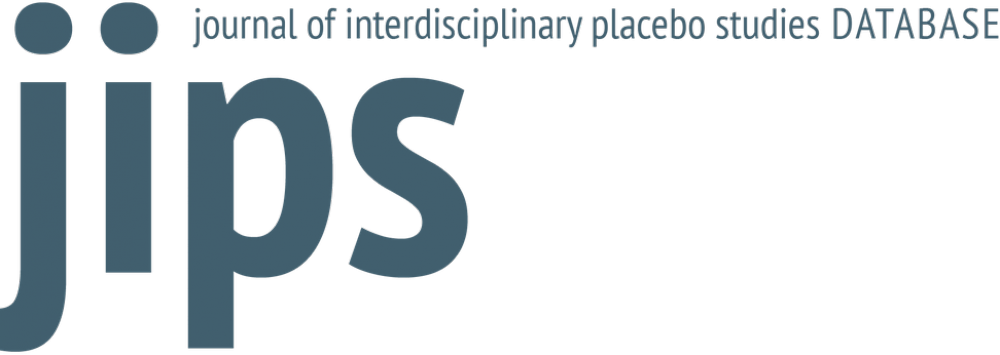Today we present 23 new placebo research papers, comments and abstracts identified during July 2017. As usual, they are based on new PUBMED publication using the search terms „placebo“ and „nocebo“ and are hand-selected from more than 715 new publications during the preceding month. Previously published monthly updates can be found in our archive. Todays selection as well as all previously identified papers will also go into our placebo research library that currently contains more than 3,500 relevant papers. If you would like to get access to the full database, please register for our newsletter and provide us with your email address and affiliation.
Bąbel, P., Bajcar, E.A., Adamczyk, W., Kicman, P., Lisińska, N., Świder, K., Colloca, L. (2017)
Classical conditioning without verbal suggestions elicits placebo analgesia and nocebo hyperalgesia. PLoS One. 12(7):e0181856. doi:10.1371/journal.pone.0181856. eCollection 2017.
https://www.ncbi.nlm.nih.gov/pubmed/28750001
Beedie, C., Whyte, G., Lane, A.M., Cohen, E., Raglin, J., Hurst, P., Coleman, D., Foad, A. (2017)
‘Caution, this treatment is a placebo. It might work, but it might not’: why emerging mechanistic evidence for placebo effects does not legitimise complementary and alternative medicines in sport. Br J Sports Med. doi:10.1136/bjsports-2017-097747. [Epub ahead of print]
https://www.ncbi.nlm.nih.gov/pubmed/28724709
Bialosky, J.E., Robinson, M.E. (2017)
Placebo disclosure does not result in negative changes in mood or attitudes towards health care or the provider. J Man Manip Ther. 25(3):151-159. doi:10.1080/10669817.2017.1298699.
https://www.ncbi.nlm.nih.gov/pubmed/28694678
Bishop, F.L., Coghlan, B., Geraghty, A.W., Everitt, H., Little, P., Holmes, M.M., Seretis, D., Lewith, G. (2017)
What techniques might be used to harness placebo effects in non-malignant pain? A literature review and survey to develop a taxonomy. BMJ Open. 7(6):e015516. doi:10.1136/bmjopen-2016-015516.
https://www.ncbi.nlm.nih.gov/pubmed/28667217
Cropsey, K.L., Schiavon, S., Hendricks, P.S., Froelich, M., Lentowicz, I., Fargason, R. (2017)
Mixed-amphetamine salts expectancies among college students: Is stimulant induced cognitive enhancement a placebo effect? Drug Alcohol Depend. 178:302-309. doi:10.1016/j.drugalcdep.2017.05.024. [Epub ahead of print]
https://www.ncbi.nlm.nih.gov/pubmed/28686989
Foster, J.C., Le-Rademacher, J.G., Feliciano, J.L., Gajra, A., Seisler, D.K., DeMatteo, R., Lafky, J.M., Hurria, A., Muss, H.B., Cohen, H.J., Jatoi, A. (2017)
Comparative “nocebo effects” in older patients enrolled in cancer therapeutic trials: Observations from a 446-patient cohort. Cancer. doi:10.1002/cncr.30867. [Epub ahead of print]
https://www.ncbi.nlm.nih.gov/pubmed/28700816
Gerdesmeyer, L., Klueter, T., Rahlfs, V.W., Muderis, M.A., Saxena, A., Gollwitzer, H., Harrasser, N., Stukenberg, M., Prehn-Kristensen, A. (2017)
Randomized Placebo-Controlled Placebo Trial to Determine the Placebo Effect Size. Pain Physician. 20(5):387-396.
https://www.ncbi.nlm.nih.gov/pubmed/28727701
Goadsby, P.J., Dodick, D.W., Lipton, R.B. (2017)
Re: Placebo responses in device studies. Cephalalgia. 333102417722498. doi:10.1177/0333102417722498. [Epub ahead of print]
https://www.ncbi.nlm.nih.gov/pubmed/28747062
Grant, J.E., Chamberlain, S.R. (2107)
The placebo effect and its clinical associations in gambling disorder. Ann Clin Psychiatry. 29(3):167-172.
https://www.ncbi.nlm.nih.gov/pubmed/28738096
Green, J., Wright, H. (2017)
From Bench to Bedside: Converting Placebo Research into Belief Activation. J Altern Complement Med. doi:10.1089/acm.2016.0375. [Epub ahead of print]
https://www.ncbi.nlm.nih.gov/pubmed/28719223
Hansen, E., Zech, N., Meissner, K. (2017)
[Placebo and nocebo : How can they be used or avoided?] [Article in German] Internist (Berl). doi:10.1007/s00108-017-0294-0. [Epub ahead of print]
https://www.ncbi.nlm.nih.gov/pubmed/28702702
Hsieh, K.H., Chen, S.J., Tsao, P.C., Wang, C.C., Huang, C.F., Lin, C.M., Chou, Y.L., Chen, W.Y., Chan, I.C. (2017)
The analgesic effect of non-pharmacological interventions to reduce procedural pain in preterm neonates. Pediatr Neonatol. doi: 10.1016/j.pedneo.2017.02.001. [Epub ahead of print]
https://www.ncbi.nlm.nih.gov/pubmed/28736177
Li, L., Li, Y., Zheng, Q. (2017)
High Placebo Response Rates Hamper the Discovery of Antidepressants for Depression in Children and Adolescents. Am J Psychiatry. 174(7):696-697. doi:10.1176/appi.ajp.2017.17030347.
https://www.ncbi.nlm.nih.gov/pubmed/28669210
Liu, J., Ma, S., Mu, J., Chen, T., Xu, Q., Dun, W., Tian, J., Zhang, M. (2017)
Integration of white matter network is associated with interindividual differences in psychologically mediated placebo response in migraine patients. Hum Brain Mapp. doi:10.1002/hbm.23729. [Epub ahead of print]
https://www.ncbi.nlm.nih.gov/pubmed/28731567
Locher, C., Nascimento, A.F., Kirsch, I., Kossowsky, J., Meyer, A., Gaab, J. (2017)
Is the rationale more important than deception? A randomized controlled trial of open label placebo analgesia. Pain. doi:10.1097/j.pain.0000000000001012. [Epub ahead of print]
https://www.ncbi.nlm.nih.gov/pubmed/28708766
Lookatch, S.J., Fivecoat, H.C., Moore, T.M. (2017)
Neuropsychological Effects of Placebo Stimulants in College Students. J Psychoactive Drugs. 1-10. doi:10.1080/02791072.2017.1344897. [Epub ahead of print]
https://www.ncbi.nlm.nih.gov/pubmed/28699832
Manchikanti, L., Boswell, M.V., Kaye, A.D., Helm, Ii. S., Hirsch, J.A. (2017)
Therapeutic Role of Placebo: Evolution of a New Paradigm in Understanding Research and Clinical Practice. Pain Physician. 20(5):363-386.
https://www.ncbi.nlm.nih.gov/pubmed/28727700
Ovosi, J.O., Ibrahim, M.S., Bello-Ovosi, B.O. (2017)
Randomized controlled trials: Ethical and scientific issues in the choice of placebo or active control. Ann Afr Med. 16(3):97-100. doi:10.4103/aam.aam_211_16.
https://www.ncbi.nlm.nih.gov/pubmed/28671148
Razavy, S., Gadau, M., Zhang, S.P., Wang, F.C., Bangrazi, S., Berle, C., Harahap, M., Li, T., Li, W.H., Zaslawski, C. (2017)
Psychophysical responses in patients receiving a mock laser within context of an acupuncture clinical trial: an interoceptive perspective. BMC Complement Altern Med. 17(1):348. doi:10.1186/s12906-017-1859-0.
https://www.ncbi.nlm.nih.gov/pubmed/28673350
Turkington, D., Spencer, H., Lebert, L., Dudley, R. (2017)
Befriending: active placebo or effective psychotherapy? Br J Psychiatry. 211(1):5-6. doi:10.1192/bjp.bp.116.197467.
https://www.ncbi.nlm.nih.gov/pubmed/28673943
Wang, X.X., Shuai, W., Peng, Q., Li, J.X., Li, P., Cheng, X.S., Su, H. (2017)
White coat effect in hypertensive patients: the role of hospital environment or physician presence. J Am Soc Hypertens. doi:10.1016/j.jash.2017.06.006. [Epub ahead of print]
https://www.ncbi.nlm.nih.gov/pubmed/28676236
Wartolowska, K.A., Gerry, S., Feakins, B.G., Collins, G.S., Cook, J., Judge, A., Carr, A.J. (2017)
A meta-analysis of temporal changes of response in the placebo arm of surgical randomized controlled trials: an update. Trials. 18(1):323. doi:10.1186/s13063-017-2070-9.
https://www.ncbi.nlm.nih.gov/pubmed/28701195
Zhang, W., Doherty, M. (2017)
Efficacy paradox and proportional contextual effect (PCE). Clin Immunol. doi:10.1016/j.clim.2017.07.018. [Epub ahead of print]
https://www.ncbi.nlm.nih.gov/pubmed/28736278
